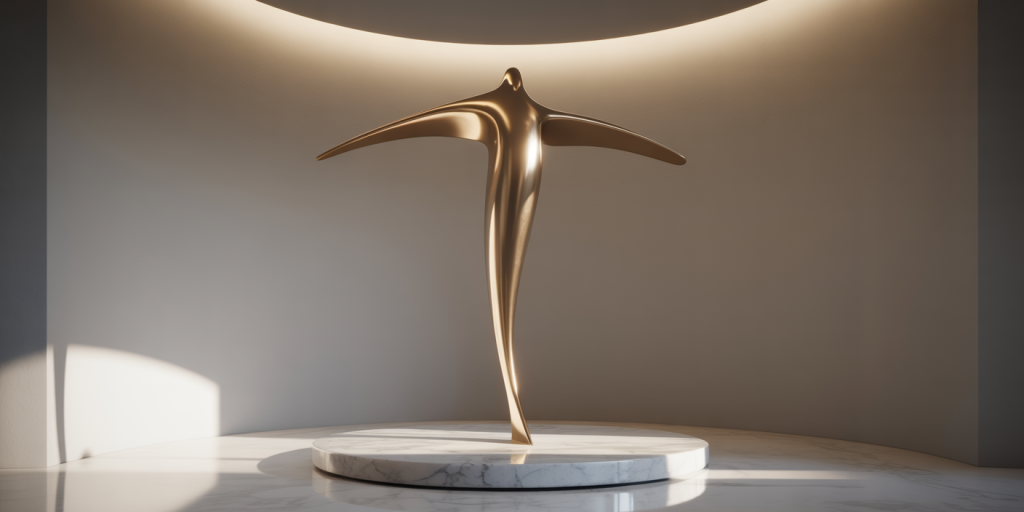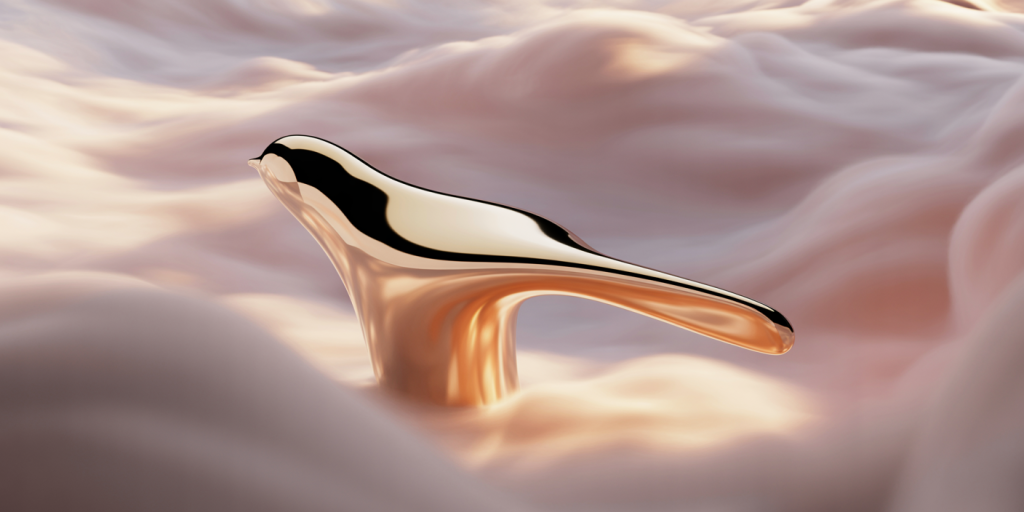The Suspended Breath of Brancusi: When Marble Wishes to Fly
There are sculptures that seem carved from rock, and there are others that feel exhaled from the soul. In the hands of Constantin Brancusi, marble is not merely stone — it becomes silence molded into gesture, breath crystallized mid-flight. One does not look at his work; one listens, as if the white curves hummed softly the lullabies of metaphysics.
Suspended in time, the forms he offered us seem to levitate on the verge of abstraction, yet are heavier than thought itself. Brancusi’s creations are not statues — they are prayers written in volume, pauses that dream of motion, wings that folded back into mineral rest. And in this tension between rise and gravity, we feel the heartbeat of eternity.
Table of Contents
- The Whisper of Polished Stillness
- Marble That Breathes
- Gravity and the Dream of Escape
- Between Egg and Bird
- The Curve as Philosophy
- Echoes of the Infinite
- Forms That Remember Silence
- The Solitude of the Essential
- Brancusi and the Flight Within
- Where Touch Meets Idea
- A Feather Made of Stone
- Sculpting the Inaudible
- Light as a Collaborator
- The Inner Pulse of Material
- Wings Without a Sky
- Tension Between Earth and Ether
- When Abstraction Becomes Emotion
- Rituals of Reduction
- Space as Sacred Companion
- The Poem Without a Voice
The Whisper of Polished Stillness
Brancusi did not carve to imitate life but to distill its essence. His sculptures whisper, not shout. They shimmer with restraint, their surfaces echoing calmness. Every curve is a hush, each form a breath held at the edge of revelation. In their silence, they speak more deeply than sound allows.
The smoothness of the surface is not aesthetic alone — it is symbolic. The polish is an erasure of chaos, a return to origin. In Brancusi’s hands, silence gleams.
Marble That Breathes
Marble, usually cold and inert, finds respiration in Brancusi’s touch. One does not feel hardness when standing before Bird in Space or The Kiss, but instead perceives rhythm, pulse, suspension. The material ceases to dominate and becomes a channel — it breathes, it sighs.
There is paradox here: permanence that feels impermanent, stone that evokes movement. We do not observe a sculpture; we inhale it, like breath shared between thought and matter.
Gravity and the Dream of Escape
Brancusi’s forms stretch upward, longing. They suggest a departure from earth, yet remain anchored in their own density. This tension — between the gravitational pull of material and the ascension of form — is where the poetry resides.
We witness an eternal contradiction: the sculptor captures not a moment, but a becoming. His marble speaks the language of clouds, though it never leaves the ground.

Between Egg and Bird
Many of Brancusi’s works hover between forms — not quite what they represent, and not entirely abstract. The egg, the bird, the flame — all emerge as archetypes, symbols of something both remembered and imagined.
The sculpture becomes an idea made flesh, a moment of evolution caught between states. What is the boundary between origin and flight? Between embryo and air? Brancusi answers with shape.
The Curve as Philosophy
Straight lines are rare in Brancusi’s work. The curve dominates — soft, infinite, circular. This is no accident. The curve, in his philosophy, is closer to nature, closer to truth. It resists rigidity. It embraces flow.
Even in abstraction, the curve invites us in. It is feminine, spiritual, and timeless. One follows the curve with the eyes and ends up circling inward, toward the self.
Echoes of the Infinite
Repetition in Brancusi’s works is not redundancy — it is meditation. His themes return in new materials, new scales, new slight changes. Each iteration whispers an echo of the infinite.
In his hands, form becomes mantra. As in chants or prayers, it is through repetition that we approach transcendence.
Forms That Remember Silence
Brancusi’s sculpture does not scream for attention. It waits. It invites. The viewer must be still to hear it. There is an internal silence in each form — the kind that remembers origin, essence, the pre-verbal world.
They are not decorative objects; they are containers of pause. In looking at them, we are gently asked to slow, to hush, to listen.
The Solitude of the Essential
In removing the unnecessary, Brancusi revealed what is essential. This is not minimalism as style, but as spiritual act. Each curve and edge was a decision toward solitude.
There is loneliness in this purity — a beauty that carries ache. To be essential is also to be alone, but in that loneliness, truth becomes visible.
Brancusi and the Flight Within
Flight is not always upward. In Brancusi’s work, it is inward. His birds do not break air — they pierce meaning. The ascent is one of spirit, of interiority, of memory. His sculptures rise not toward sky, but toward soul.
Thus, they carry more than form — they are metaphors in marble.

Where Touch Meets Idea
Brancusi once said that to see far is one thing, but to go there is another. His works are the journey of that going — where idea becomes form through the intimacy of touch. His hands, guided by vision, were instruments of memory.
Each sculpture is not only conceived — it is touched into being, each surface a diary of fingers.
A Feather Made of Stone
The contradiction of Brancusi: the feather that weighs tons, the bird that never flew. But he sculpts not the thing, but its essence. A feather is not its weight, but its suggestion of lightness. He offers us that — the feel of floating, carved in permanence.
Sculpting the Inaudible
Some sounds are not meant for ears. Brancusi’s forms are soundless songs — chants in mineral language. They vibrate without frequency. They sing to memory, to intuition.
To look at one is to hear what cannot be heard, to feel a voice the body recognizes before the mind does.
Light as a Collaborator
His sculptures do not exist in isolation. Light is their partner. It slides, caresses, highlights. As daylight changes, so does the mood of the form. Morning reveals one thing; dusk, another.
This is no accident. The polish invites this dance. His pieces are not static — they shift under sun, glow under thought.
The Inner Pulse of Material
Brancusi believed that within every block of marble lived a rhythm — the task of the artist was to find and release it. His process was not forceful but intuitive. He did not impose form — he revealed it.
What we see is not invention, but liberation.
Wings Without a Sky
The birds of Brancusi do not need wings. They rise in suggestion. Their verticality, their elegance, is enough. They do not flap or dive — they glide in thought. They rise not through feathers but through faith.
And we, the viewers, follow.

Tension Between Earth and Ether
Each sculpture lives in this liminal space — not fully earth, not fully air. Anchored in material, yet evoking escape. It is in this space that Brancusi’s work transcends sculpture and becomes meditation.
He gives shape to the in-between, the interstice where meaning forms.
When Abstraction Becomes Emotion
His abstractions are not cold. They do not alienate. They feel, they ache, they remember. In removing the obvious, he made room for the intimate. The viewer brings their own associations — and is never rejected.
In this, his work becomes a mirror of quiet feelings.
Rituals of Reduction
Brancusi’s studio was a temple of reduction. Every chip was a devotion. Every sanding, a prayer. Reduction was not subtraction — it was arrival. He carved not until nothing was left, but until only the necessary remained.
In that act, truth was revealed.
Space as Sacred Companion
The space around his sculptures is never empty. It participates. Brancusi understood that negative space holds breath. Each form requires air to be complete. In this relationship between form and void, meaning circulates.
The sculpture ends not where the marble stops, but where your gaze begins.
The Poem Without a Voice
If a poem could be held, if silence could take shape, it would resemble a Brancusi sculpture. There is verse in the balance, rhyme in the repetition, a cadence in the curves.
His work is a poem without letters — yet the soul reads it fluently.
FAQ
Who was Constantin Brancusi?
A Romanian-born sculptor (1876–1957), considered one of the pioneers of modernism. His work is known for its simplicity, spirituality, and radical abstraction.
What is Brancusi’s most famous work?
“Bird in Space” is among his most iconic, symbolizing flight through minimalist form.
Why did Brancusi use abstraction?
He sought to express the essence of things, not their literal appearance. Abstraction allowed him to reach universal truths.
What materials did he favor?
Brancusi worked with marble, bronze, wood, and stone — materials he considered sacred, full of inner rhythm.
What was his artistic philosophy?
He believed in revealing, not creating — that every material held a truth, and the sculptor’s task was to uncover it.
Final Reflections – The Breath Behind the Stone
In Brancusi’s hands, marble does not resist — it exhales. His sculptures are the memory of movement, the echo of dreams that never needed to wake. We do not just see them — we feel the space around them shift, the silence within us deepen.
Each form is a suspended breath — not yet vanished, not yet complete. And in standing before it, we too suspend: our thoughts, our noise, our forgetting.
For in Brancusi’s world, even stone remembers how to fly.
